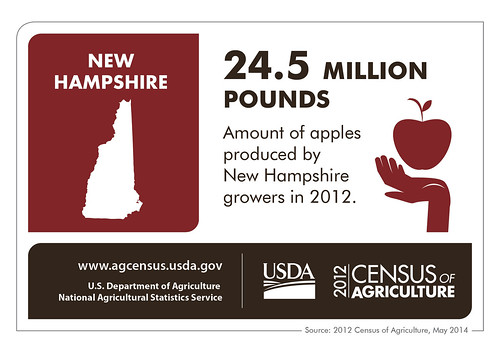
The Census of Agriculture is the most complete account of U.S. farms and ranches and the people who operate them. Every Thursday USDA’s National Agricultural Statistics Service will highlight new Census data and the power of the information to shape the future of American agriculture.
Agriculture is probably not the first thing that pops into your head when you think of New Hampshire. As the 2012 Census of Agriculture results show, however, farming is a major component of our state’s economy. In 2012, our farmers sold nearly $200 million worth of agricultural products.
Milk production has been one of New Hampshire’s leading agricultural products for decades. In 2012, our milk cows produced more than 3 million gallons of milk, which was worth nearly $55 million. Recently, egg production has been increasing. There were also more than 320,000 chickens in New Hampshire in 2012. As a result, New Hampshire had nearly $13.5 million of poultry and egg sales in 2012.
Since we have cooler winters than many other parts of the country, many New Hampshire growers use greenhouses to raise vegetables, flowers, and other plants. Greenhouse sales alone reached almost $2.4 million in 2012. In fact, nursery, greenhouse, and sod production is one of our leading sectors of agriculture, with nearly $50 million in sales.
Our key fruit crop is apples. In 2012, New Hampshire farmers harvested more than 24.5 million pounds of apples. That’s more than $6 million worth of apples! And while our state may not have the most farmland in the United States, we have nearly 4,000 acres dedicated to vegetable production, so our residents can get those important vitamins. To top it off, our maple syrup production continue to grow. In 2012, our farmers produced more than 82,574 gallons of syrup, worth almost $3.6 million.
New Hampshire leads the nation in the percent of farms selling products directly to the public for human consumption at 10.6 percent. These direct sales make up more than 30 percent of total agricultural sales. This includes the 4.9 percent of all farms selling through community supported agriculture arrangements (CSAs). Also, 13.7 percent of our farms sold wholesale directly to retailers such as grocery stores, restaurants, schools, and other institutions-the 5th highest in the nation.
While these are all important aspects of our state’s agriculture, what is especially of note is that we continued to buck the national trend of decreasing farm numbers. While the number of farms around the country dropped by 4 percent since the last census, our farm numbers grew 5 percent since 2007. Our farmland acreage also grew by 4 percent since the 2007 Census of Agriculture. This increase continues the increase that emerged in New Hampshire in the 2002 census.
Together, these statistics show that agriculture has a major presence in our state. It has been so exciting to see the results of the 2012 Census that I’m already looking forward to 2017 Census of Agriculture to see if we continue growing this crucial sector.
